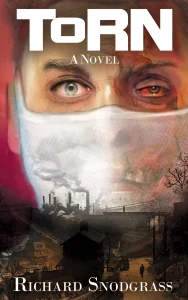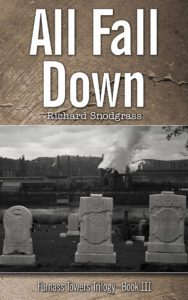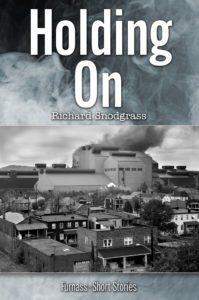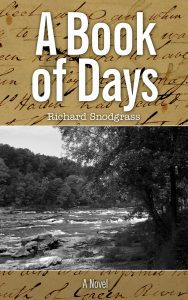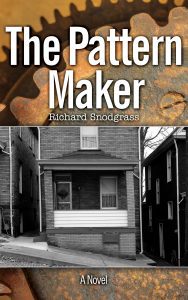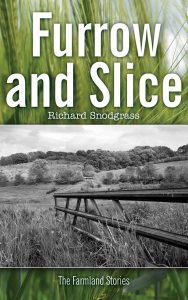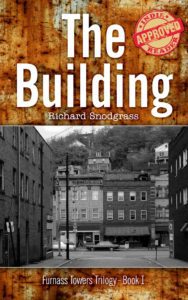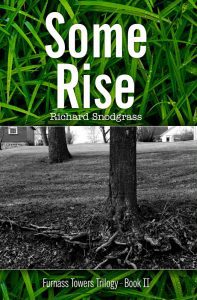The thirteen stories of Holding On show life in Furnass during the late 1970s and early 1980s, a time of prosperity for a Western Pennsylvania mill town, though there are intimations of change, rumors of mill closings and layoffs. Interweaving with these stories is a tale of two Scottish soldiers two hundred years earlier in the same area, struggling through the virgin forest along the Allehela River looking for lost sheep. The counterpoint of stories creates a collective portrait of people, then and now, as life changes about them, doing their best to hold on.

Videos
Reader’s Guide to HOLDING ON
Summary
Holding On, a collection of short stories, opens with the 1764 narrative of two soldiers of the Forty-Second Royal Highland Regiment of Foot as they pursue a lost flock of sheep through what will eventually become the fictional town of Furnass, Pennsylvania. From there, the soldiers’ tale is woven among fourteen short stories set in Furnass between the 1950s and the 1980s. One story focuses on a twelve-year-old boy who has several unsettling encounters during the course of a single day that force him to reevaluate how he views the world. Another narrates the story of a break-in from the perspectives of both the elderly homeowner and the trespasser. An abusive husband, his wife, and his partner on the police force are at the center of another story as they deal with a life-changing injury. Regardless of the subject, all the stories in this collection offer snapshots of ordinary people in extraordinary circumstances, simply trying to get by. Written with lyrical realism, insight, and compassion, Holding On paints a memorable portrait of life in a small town and all it entails: a balance between love and indifference, jealousy and trust, work and play.
Questions and Topics for Discussion
- Why do you think Snodgrass chose to arrange the stories out of chronological order? Can you see a method to the way he has ordered them?
- Discuss Snodgrass’s decision to set the soldiers’ story in italics and interrupt it with twentieth-century narratives. Apart from the setting, what parallels can you draw between the soldiers’ story and the others?
- Compare “Almost a Shutout” with the others in the collection in terms of how it portrays loss and the passage of time. Are the characters’ coping mechanisms unique to the experience of living in a small town like Furnass?
- A William Maxwell quotation—“With small town people, every story is part of some other story”—serves as the book’s epigraph. Can you identify “some other story” in each of the stories in Holding On? Are these other stories explicit or implicit?
- Only two stories in this collection, “Larry-Berry” and “Meeting of Minds,” are written from a first-person perspective. Why do you think the author chose this device for these two stories? In what other ways are these two stories similar?
- How do the stories in this collection mesh with Snodgrass’s various Furnass novels? Do the stories in Holding On shed any light on the novels or vice versa?
- At one point in “Larry-Berry,” Larry muses, “But, you know, it’s hard to ignore somebody you don’t like. It’s harder to ignore someone you don’t like than it is to pay attention to somebody you do like.” Do you find this to be true? Discuss instances of this within your own life and within the context of the other stories in Holding On.
- Discuss why you think Snodgrass chose “Holding On” as the title story. What makes this the best representation of the collection as a whole?
- James Joyce’s Dubliners is another collection of short stories that focuses on the lives of the inhabitants of a single town (or, in Joyce’s case, a city). How do Joyce and Snodgrass differ in their approaches? What similarities can you draw, despite the differences between locales and time periods?
- Do you think Snodgrass has sympathy for some of his characters more than others? Are there any characters in Holding On for whom he does not appear to have sympathy?
Reviews, Extra Scenes, etc.
Full Review – Kirkus Reviews
A collection of short stories documents the beginning of the end of a western Pennsylvania steel town.
Furnass, Pennsylvania, runs on steel mills: “The mills were a fact of life in Furnass, any part of Furnass, the same as the hills and the river and the trees; there was always the rust-covered smoke drifting over the valley, the steam from the coke ovens billowing up like huge genies to dull the sun.” In these 13 stories, set from the early 1950s to the early ’80s, the town’s citizens live and learn in the relative comfort of the steel economy—despite persistent rumors that it might all be going away. A 12-year-old boy buys a set of toy soldiers from a military antiques shop, intrigued by the rumors that surround the store’s handsy owner. Afterward, he encounters a different sexual ritual playing out in the woods near his home: one that ends, inevitably, with territorial violence between the town’s teenage gangs. Three former high school football players—now steelworkers—reminisce about a teammate who made it out of town with a mix of admiration and resentment. A Furnass mechanic is called to work on a Porsche that has broken down on the outskirts of town, which leads to a bit of class tension with the foreign car’s owner. Snodgrass (Across the River, 2018, etc.) shows how the fault lines that exist in any society—between men and women, friends and strangers—are only exacerbated once economic anxieties begin to rear their head. In the final tale, the eponymous “Hold On,” mill closures and layoffs haunt a social occasion involving three co-workers. A restored motorcycle appears to provide a welcome distraction from the uncertainty, but it proves to be a painful metaphor for the whole thing.
The author’s measured, plainspoken prose appropriately calls to mind the dirty realism of the ’80s. “I finally give up and go home,” narrates one damaged protagonist, a burglar and drug addict. “It’s been a while since I broke in there, and when I’m hanging out at Mikey’s All-Niter and the old dolly comes in, I’m careful to stay out of sight. Somebody put another sheet of plywood over that transom, so it’s better to lay low for a while and let things cool down.” Between the stories, Snodgrass includes a series of Hemingway-esque interludes, which follow two Scottish soldiers back in 1764 as they hack their way through the forest that will one day be Furnass: a de facto foundational myth that foreshadows the struggles of the region’s subsequent inhabitants. The result is a convincing meditation on the nature of work and manhood in industrial America (for these are tales about men and their particularly male insecurities; a weakness of the book is that women generally appear only as wives, mothers, or objects of sexual desire). The author makes great use of a linked short story collection’s ability to capture a time and place, with each piece shining brighter when reflected off the others.
A finely crafted, often haunting portrait of a steel town and its men.
Full Review – Self-Publishing Review (SPR)
Brimming with rustic energy and written in an authentically American voice, Holding On by Richard Snodgrass is a surprising collection of stories that capture the rise and imminent fall of Furnass, a small American town like so many others.
In the industrial boom of the 20th century, mill towns were enjoying their heyday, driving the great machine of the nation forward. Given the perspective of time, however, modern readers know that this would be a temporary golden age, one still gasping out its death rattles to this day. Within this framework of transient prosperity and bold hope for the future, these thirteen stories are both charming and heartbreaking, imbued with a sense of impending loss.
These anecdotal stories probe deep into human nature and connection, exploring the foolishness of youth, the pain of ignorant belief systems, and the challenges of poverty. The rumors and offhand remarks of the various characters scattered in this hardy Pennsylvania town are dark harbingers of what’s to come. Some of the characters appear in multiple stories, and the puzzle pieces of this quintessentially American town slowly begin to fall into place.
Woven between these stories is the tale of two other men, Scottish soldiers from the 18th century who walked the very same fields and valleys of Pennsylvania. Like the men and women who populate Furnass in the 1980s, these wanderers are seeking their own place in a changing world, striving for happiness, or at least survival. These brief interludes of Hugh and Duncan, the Scottish Highlanders, allow time for readers to breathe – functioning as occasional palate cleansers that also happen to be delectable. Some of the longer pieces also touch on the rich history of the Scots in the area, broadswords and all, subtly linking the stories together.
Given that industrial towns like Furnass are scattered across America, each with their own proud or tragic history, this collection holds a broad appeal. In fact, certain elements seem quite timely, or timeless, such as the complexity of race relations and gentrification, the pain of unrequited love, and the need for personal evolution. The landscape of the region is as much a character as any townsperson, and Snodgrass writes with a visceral passion born from true adoration for the Northeast. The colloquial nature of the characters’ speech and the minute details Snodgrass includes makes this an immersive and engaging portrait. Fictionalized as they may be, the lives of the characters are relatable and inspiring.
The technical elements of the book are strong, with only a few moments that feel sluggish or poorly penned. Every story has its own energy, and despite centering on the same small town, there are thousands more tales that could have been told. Snodgrass has a keenly compassionate eye for human nature and an excellent ear for sincere speech. The narration is also clever and dense, painting a vivid picture for those readers eager to get lost in the past.
Exposing universal themes through an intensely intimate portrait of America, Holding On is a powerful achievement from a truly standout author.
Full Review – IndieReader
HOLDING ON, the latest in an eight-book series by author Richard Snodgrass, recounts the good, the bad, and the ugly in the two-hundred year history of a struggling mill town.
Furnass is “a typical midwestern Pennsylvania mill town,” according to Richard Snodgrass’s website. Except it exists only in The Books of Furnass, an eight-volume series chronicling the town’s history from the aftermath of the French and Indian War through the late 20th century. HOLDING ON is the latest in the series, a linked collection of stories set between 1952 and 1986.
The stories contained HOLDING ON evoke Stephen King at his most nostalgic: elaborate set pieces of some bygone era in mill-town America. They share a location but not characters, though at least some of them probably appear in other books in the series. Some stories are fully-formed; others seem like beginnings that are later abandoned. In “Flowers of the Forest,” a young boy gets an introduction to sex, then to violence, learning, perhaps, how the two can spring from the same source. “Making Do” explores how a pretty young visitor shakes up a family’s dynamic. The best of the bunch is “Larry-Berry,” for the wit of its narrator, and its light-hearted twist to the age-old problem of a troubled marriage.
The stories explore familiar themes: loneliness, confusion, coming of age, the weight of history, small-town violence. Humor arises naturally from situations, though there are some good one-liners, such as Larry-Berry’s observation “I was afraid she’d lose her balance and fall on me and make me as one-sided as a nickel.” There are a few questionable decisions. Readers may be confused by the similarly named Bob Binder and Bob Bodner. And nobody in western Pennsylvania would call his mother “mum.” Between stories are italicized interludes of a pair of explorers in 1764, when the area was overgrown and unsettled. These vignettes add little to HOLDING ON, which without them would be an heir to Winesburg, Ohio. With them, it feels like an MFA thesis. Yet the time period marks the beginning of Snodgrass’s larger story, which would surely suffer from these episodes’ exclusion.
IR Verdict: Witty and poignant, and occasionally ribald, HOLDING ON is a worthy addition to the Snodgrass’s epic tale of a town in America’s heartland.
Additional Story: “Tell Me What a God Sees”
Introduction to the story, “Tell Me What a God Sees.”
This story, “Tell Me What a God Sees,” owes much to William Faulkner’s short stories about the history of his fictitious Yoknapatawpha County, linked together in the Collected Stories under the heading of The Wilderness, particularly the stories “Red Leaves” and “A Justice.” Now, although Faulkner had a huge influence on me at one time of my life, particularly in freeing me to allow my imagination to go wherever it would, I’ve never been a fan of the majority of his short stories. Too often they seemed too rambling and sentimental, my ideal tending to the classicism of the stories in James Joyce’s The Dubliners. But as the story came to me during the late 1980s while I was putting together the stories that became the collection Holding On, I was reminded of Faulkner’s characters of Doom (the anglicized version of “Du Homme” or The Man) and Moketubbe and the improbable but amusing settings and situations of these stories. The story obviously didn’t fit with the other stories of the collection and I wondered for years what I would do with it. I’m happy that it finally found its home on this website.
A mystery for anyone studying the Indians of Western Pennsylvania are the groups called the Monongahela People. Wikipedia tells us the following:
The Monongahela culture were a Native American cultural manifestation of Late Woodland peoples from AD 1050 to 1635 in present-day western Pennsylvania, western Maryland, eastern Ohio, and West Virginia.[1] The culture was named by Mary Butler in 1939 for the Monongahela River, whose valley contains the majority of this culture’s sites.[2]
The Monongahela practiced maize agriculture, and lived in well laid out villages, some of which consisted of as many as 50-100 structures. They traded with other Indian groups who in turn traded with Europeans. The Monongahela seem to have disappeared some time during the 1620s or 1630s before having significant direct contact with Europeans.
No one is certain where they came from, nor do they know where they went to; they seemed to have just disappeared. There are a number of theories of course: wiped out by disease or drought; killed off by more belligerent tribes. I first came across mentions of the Monongahela People while I was finishing up my first novel, There’s Something in the Back Yard, the story of what happens when an average American runs up against the Hopi Indian culture in the presence of a kachina named Aholi. At the same time I was starting to do research for the series that would become the Books of Furnass by reading the history of my hometown of Beaver Falls and the mill towns along the Ohio and Beaver Rivers. My own theory is that the groups we call the Monongahela People were actually clans of the Hopi on their migrations to cover the reaches of their home in the Fourth World. The story explains more of these migrations, and how they fit into the basic situation that the characters find themselves in. It also explains how the Aholi, a main character in my first novel, There’s Something in the Back Yard, finds himself in Western Pennsylvania at the future site of the mill town of Furnass.
“Along the River” as Photo/Text Story
Introduction to Photo/Text story, “Along the River.”
I’ve long been interested in the possible marriage of photographs and text, since the time I first encountered the early work of Wright Morris, particularly his collection, God’s Country and My People. I’ve had some success with the form in non-fiction, such as my books Kitchen Things and An Uncommon Field: The Flight 93 Temporary Memorial. A later book of fiction to be published in the Books of Furnass series, Furrow and Slice: The Farmland Stories, uses the basic form of a page or page-and-a-half of self-contained prose of a short-short story (no more than 500 words) facing a page with a photograph, the same basic form that I’ve used for non-fiction. But this story is an attempt to use the form with a longer continuous narrative with a story from the Holding On collection.
“Anyway” as Screenplay
The following is an attempt to adapt my short story “Anyway” into a short film.
